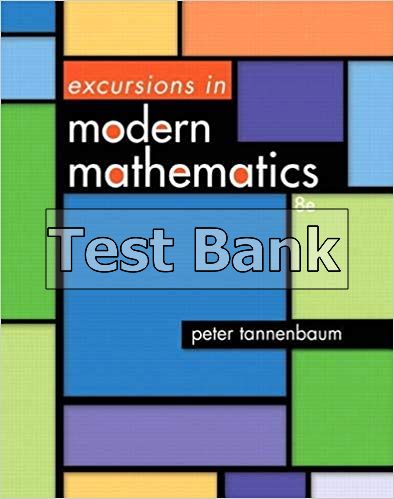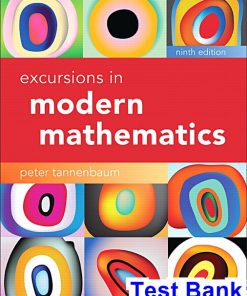Excursions in Modern Mathematics 8th Edition Tannenbaum Test Bank
$26.50$50.00 (-47%)
Excursions in Modern Mathematics 8th Edition Tannenbaum Test Bank.
You may also like
-
$26.50
$50.00
This is completed downloadable of Excursions in Modern Mathematics 8th Edition Tannenbaum Test Bank

Product Details:
- ISBN-10 : 032182573X
- ISBN-13 : 978-0321825735
- Author: Peter Tannenbaum
Table of Content:
PART 1 THE MATHEMATICS OF SOCIAL CHOICE Chapter 1. The Mathematics of Voting: The Paradox of Democracy Preference Ballots and Preference Schedules The Plurality Method The Borda Count Method The Plurality-with-Elimination Method (Instant Runoff Voting) The Method of Piecewise Comparisons Rankings Profile: Kenneth J. Arrow Key Concepts Exercises Projects and Papers References and Further Readings Chapter 2. The Mathematics of Power: Weighted Voting Systems 2.1 An Introduction to Weighted Voting 2.2 The Banzhaf Power Index 2.3 Applications of the Banzhaf Power Index 2.4 The Shapely-Shubik Power Index 2.5 Applications of the Shapely-Shubik Power Index Profile: Lloyd S. Shapely Key Concepts Exercises Projects and Papers References and Further Readings Chapter 3. The Mathematics of Sharing: Fair-Division Games 3.1 Fair-Division Games 3.2 Two Players: The Divider-ChooserMethod 3.3. The Lone-Divider Method 3.4 The Lone-Chooser Method 3.5 The Last-Diminisher Method 3.6 The Method of Sealed Bids 3.7 The Method of Markers Profile: Hugo Steinhaus Key Concepts Exercises Projects and Papers References and Further Readings Chapter 4. The Mathematics of Apportionment: Making the Rounds 4.1 Apportionment Problems 4.2 Hamilton's Method and the Quota Rule 4.3 The Alabama and Other Paradoxes 4.4 Jefferson's Method 4.5 Adams's Method 4.6 Webster's Method Historical Note Key Concepts Exercises Projects and Papers References and Further Readings Mini-Excursion 1: Apportionment Today PART 2 MANAGEMENT SCIENCE Chapter 5. The Mathematics of Getting Around: Euler Paths and Circuits 5.1Euler Circuit Problems 5.2 What is a Graph? 5.3 Graph Concepts and Terminology 5.4 Graph Models 5.5 Euler's Theorems 5.6 Fleury's Algorithm 5.7 Eulerizing Graphs Profile: Hugo Steinhaus Key Concepts Exercises Projects and Papers References and Further Readings Chapter 6. The Mathematics of Touring: The Traveling Salesman Problem 6.1 Hamilton Circuits and Hamilton Paths 6.2 Complete Graphs 6.3 Traveling Salesman Problems 6.4 Simple Strategies for Solving TSPs 6.5 The Brute-Force and Nearest-Neighbor Algorithms 6.6 Approximate Algorithms 6.7 The Repetitive Nearest-Neighbor Algorithm 6.8 The Cheapest Link Algorithm Profile: Sir William Rowan Hamilton Key Concepts Exercises Projects and Papers References and Further Readings Chapter 7. The Mathematics of Networks: The Cost of Being Connected 7.1 Trees 7.2 Spanning Trees 7.3 Kruskal's Algorithm 7.4 The Shortest Network Connecting Three Points 7.5 Shortest Networks for Four or More Points Profile: Evangelista Torricelli Key Concepts Exercises Projects and Papers References and Further Readings Chapter 8. Chasing the Critical Path: The Mathematics of Scheduling 8.1 The Basic Elements of Scheduling 8.2 Directed Graphs (Digraphs) 8.3 Scheduling with Priority Lists 8.4 The Decreasing-Time Algorithm 8.5 Critical Paths 8.6 The Critical-Path Algorithm 8.7 Scheduling with Independent Tasks Profile: Ronald L. Graham Key Concepts Exercises Projects and Papers References and Further Readings Mini-Excursion 2: Graph Coloring PART 3 SHAPE, GROWTH, AND FORM Chapter 9. The Mathematics of Spiral Growth in Nature: Fibonacci Numbers and the Golden Ratio 9.1 Fibonacci's Rabbits 9.2 Fibonacci Numbers 9.3 The Golden Ratio 9.4 Gnomons 9.5 Spiral Growth in Nature Profile: Leonardo Fibonacci Key Concepts Exercises Projects and Papers References and Further Readings Chapter 10. The Mathematics of Money: Spending it, Saving It, and Growing It 10.1 Percentages 10.2 Simple Interest 10.3 Compound Interest 10.4 Geometric Sequences 10.5 Deferred Annuities: Planned Savings for the Future Key Concepts Exercises Projects and Papers References and Further Readings Chapter 11. The Mathematics of Symmetry: Beyond Reflection 11.1 Rigid Motions 11.2 Reflections 11.3 Rotations 11.4 Translations 11.5 Glide Reflections 11.6 Symmetry as a Rigid Motion 11.7 Patterns Profile: Sir Roger Penrose Key Concepts Exercises Projects and Papers References and Further Readings Chapter 12. The Geometry of Fractal Shapes: Naturally Irregular 12.1 The Koch Snowflake 12.2 The Sierpinski Gasket 12.3 The Chaos Game 12.4 The Twisted Sierpinski Gasket 12.5 The Mandelbrot Set Profile: Benoit Mandelbrot Key Concepts Exercises Projects and Papers References and Further Readings Mini-Excursion 3: The Mathematics of Population Growth: There is Strength in Numbers PART 4 STATISTICS Chapter 13. Collecting Statistical Data: Censuses, Surveys, and Clinical Studies 13.1 The Population 13.2 Sampling 13.3 Random Sampling 13.4 Sampling: Terminology and Key Concepts 13.5 The Capture-Recapture Method 13.6 Clinical Studies Profile: George Gallup Key Concepts Exercises Projects and Papers References and Further Readings Chapter 14. Descriptive Statistics: Graphing and Summarizing Data 14.1 Graphical Descriptions of Data 14.2 Variables 14.3 Numerical Summaries of Data 14.4 Measures of Speed Profile: W. Edwards Deming Key Concepts Exercises Projects and Papers References and Further Readings Chapter 15. Chances, Probabilities, and Odds: Measuring Uncertainty 15.1 Random Experiements and Sample Spaces 15.2 Counting Outcomes in Sample Spaces 15.3 Permutations and Combinations 15.4 Probability Spaces 15.5 Equiprobable Spaces 15.6 Odds Profile: Persi Diaconis Key Concepts Exercises Projects and Papers References and Further Readings Chapter 16. The Mathematics of Normal Distributions: The Call of the Bell 16.1 Approximately Normal Distributions of Data 16.2 Normal Curves and Normal Distributions 16.3 Standardizing Normal Data 16.4 The 68-95-99.7 Rule 16.5 Normal Curves as Models of Real-Life Data Sets 16.6 Distributions of Random Events 16.7 Statistical Inference Profile: Carl Friedrich Gauss Key Concepts Exercises Projects and Papers References and Further Readings
People Also Search:
excursions in modern mathematics tannenbaum
excursions in modern mathematics 8th edition tannenbaum
excursions in modern mathematics 8th edition
excursions in modern mathematics 8th edition testbank download pdf
excursions in modern mathematics 8th edition download scribd












